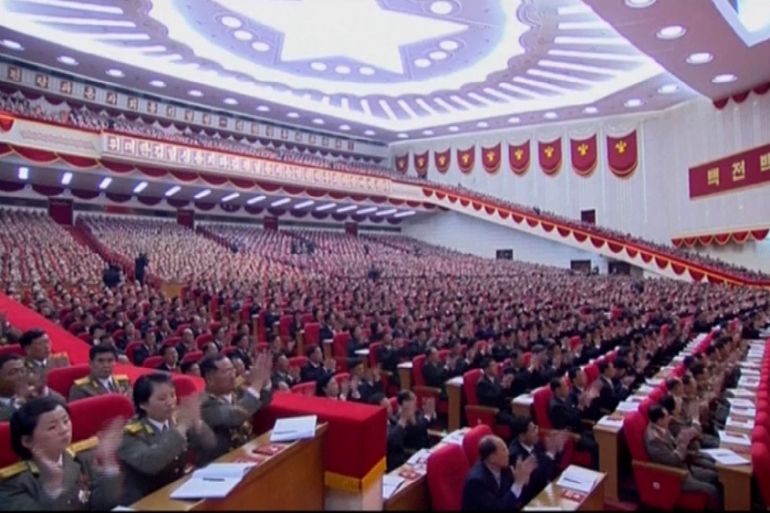North Korea cements Kim Jong-un at the top
The bottom-line for Kim, will always focus on regime stability.

On May 6, North Korea opened its seventh Workers’ Party Congress (WPC) in Pyongyang amidst much pomp and ceremony. Before this week’s meeting, a WPC had not occurred in the North for almost 40 years, since the 1980 session, which served as a grooming event for Kim Jong-un’s late father, Kim Jong-il.
The WPC event is intended to be a showcase to cement the power of Kim and the Korean Workers’ Party (KWP), which has experienced a gradual erosion of power over the past two decades.
Keep reading
list of 4 itemsNorth Korea says Kim Jong Un oversaw test of new hypersonic weapon
North Korea claims progress in development of hypersonic missile
North Korea’s Kim oversees ‘super-large’ rocket launcher drills
The event also provides a platform for Kim to trumpet the North’s status as a “nuclear weapons state” – a notion that the regime believes adds to its legitimacy and provides deterrence against the United States and South Korea.
‘Byungjin’ policy
Since Kim assumed the leadership post in 2012, Pyongyang has consistently worked to improve its nuclear weapons and ballistic missile capacities in defiance of protests and additional sanctions from the international community (PDF).
In addition to providing a stage to launch propaganda on its nuclear programme, the Congress is a platform to formally adopt Kim’s policy of “byungjin” – which dovetails the North’s development of nuclear weapons alongside its priority of economic growth and development (PDF).
In early 2013, Kim announced the strategy at a plenary meeting of Central Committee of the KWP. However, Kim’s promotion of a so-called balanced policy seems contradictory to North Korea’s recent string of provocations leading up to the Congress – highlighted by the country’s fourth nuclear test, multiple ballistic missile tests and further work on miniaturisation of nuclear warheads.
But, the rationale behind these provocations was a push towards a legitimate nuclear weapons capacity ahead of the WPC – so that Kim could showcase the regime’s strength and fend off criticism of new reforms on the economy or challenges to his rule.
The adoption of byungjin signals the formal end of the “songun” (or “military first”) policy brought forward by Kim’s father, Kim Jong-il.
At the time, the songun policy was intended to show a firm hand and cement the role of the Korean People’s Army (KPA) as a central power base in the country.
The combination of the internal purges and the exterior provocations has been building to this moment so that Kim can showcase both internally and to a global audience his unquestioned control of the country.
Kim Jong-il, similar to his son, worried about the KPA’s growing strength and the subsequent threat to his rule.
The new balanced policy, along with the first WPC in nearly 40 years, is thus intended not only to solidify the power base on Kim, but also aims to restrain the power of the KPA.
More importantly, the coronation of Kim at the top is meant to ensure loyalty from all power brokers in the North – especially those in the military.
Overcoming isolation
This insecurity at the top was demonstrated clearly over last three years of Kim’s reign through which the leader undertook a number of ruthless purges of close aides and high-level officials.
The most notable of these was the purge of Jang Song Taek in December 2013, Kim’s uncle and a key adviser to the regime during the rule of Kim Jong-il.
Subsequently, there have been a host of other purges of powerful party officials and members of the military including the alleged executions of former Defence Minister Hyon Yong-chol in April 2015 and General Ri Yong-gil this past February.
OPINION: Now North Korea has nothing to lose
The combination of the internal purges and the exterior provocations – especially through the development of the North’s nuclear programme – has been building to this moment so that Kim can showcase – both internally and to a global audience – his unquestioned control of the country.
In this sense, it is quite possible that there will be a reduction in provocations after the WPC due to Kim’s feeling of greater stability.
This is not to imply that there will be a rapid emergence of a reform movement in the North. Rather, Kim may begin to incrementally pursue more economic development goals of his byungjin policy.
The bottom-line for Kim, however, will always focus on regime stability, and it is important to recognise that any reforms of the economic sector are aimed solely with this purpose in mind.

The focus on stability has been underscored by the massive presence of security surrounding the WPC.
Another interesting element of the meeting is the notable lack of significant foreign dignitaries. In previous Congresses, the North had invited several high-level diplomats and foreign leaders to attend the ceremonies.
The lack of key foreign representatives is a sign of Pyongyang’s weakening relationships with some of its key partners – most notably that with China.
North Korea’s trajectory after the WPC continues to be muddied, but one thing is clear: This is Kim’s moment, and the Congress is centred on rallying around Kim as the omnipotent leader for years to come.
J Berkshire Miller is the director of the Council on International Policy and is a fellow on East Asia for the EastWest Institute.
The views expressed in this article are the author’s own and do not necessarily reflect Al Jazeera’s editorial policy.
